Texas Democratic Party
Texas Democratic Party | |
|---|---|
| Chairman | Vacant[1] |
| Senate Minority Leader | Carol Alvarado |
| House Minority Leader | Trey Martinez Fischer |
| Founded | 1846 |
| Headquarters | P.O. Box 15707 Austin, Texas 78761 |
| Ideology | Modern liberalism |
| National affiliation | Democratic Party |
| Colors | Blue |
| State Senate | 12 / 31 |
| State House of Representatives | 64 / 150 |
| Statewide Executive Offices | 0 / 9 |
| Board of Education | 6 / 15 |
| U.S. Senate | 0 / 2 |
| U.S. House of Representatives | 12 / 38 |
| State Supreme Court | 0 / 9 |
| Website | |
| www | |
The Texas Democratic Party is the affiliate of the Democratic Party in the U.S. state of Texas and one of the two major political parties in the state. The party's headquarters are in Austin, Texas.[2]
President Lyndon B. Johnson was a Texas Democrat. 39 out of the 48 politicians who have served as Governor of Texas have been Texas Democrats. The party used to be the dominant political party in Texas; however, like in other Southern states, its rival, the Republican Party of Texas has become the dominant party since the 1990s. Texas has not elected any Democratic candidates to statewide office since 1994.
The party used to support racial segregation and held white-only primaries until Terry v. Adams; however, the party has adopted liberal attitudes on race and other matters since the 1960s.[3][4][5]
Similar to the national Democratic Party, the Texas Democratic Party currently supports abortion access, cannabis legalization, LGBT rights, environmentalism, gun control, Medicaid expansion, and raising the minimum wage.[6] Black Texans, Hispanic Texans, young Texans, and Texans who live in urban areas are more likely to support the Texas Democratic Party than other demographic groups.[7] However, Hispanic Texans have moved to the Republican Party in recent elections.[8]
History
[edit]Prior to the Annexation of Texas, the Democratic Party had a foothold in the politics of the region. A powerful group of men that called themselves the "Texas Association" served as an early prototype for the Democratic Party of Texas. The Texas Association drew its membership from successful merchants, doctors, and lawyers, often traveling from Tennessee. Many members of the Texas Association were close friends of Andrew Jackson, and most had strong ties to the Democratic Party. Similarly, most of the other settlers in Texas were from states in the South, and white American southerners of this era generally held strong allegiances to the Democratic Party.[9]
In 1845, the 29th United States Congress approved the Texas Constitution and President James K. Polk signed the act admitting Texas as a state on December 29. In 1848, the party convention system was adopted, and it quickly became the primary method of selecting candidates for the Texas Democratic Party. In the period prior to the Civil War, national politics influenced the state party's perspective. Texas Democrats began to discard Jacksonian nationalism in favor of the states' rights agenda of the Deep South. A conflict emerged within the Party between a minority of pro-Union Democrats and a majority of secessionists. During the war, supporters of the Union disappeared from the political scene or moved north. Those who stayed politically active supported the Confederacy. During Reconstruction, the rift between Unionist and Secessionist Democrats remained. For a short period immediately after the war, the Texas Democratic Party was a formidable political force, but they quickly split apart because their positions on freedmen varied greatly; some supported basic civil rights, while most opposed anything more than emancipation. As a result, Republicans captured both the governor's office and the Texas Legislature in 1869, but Republican political dominance in the post-Civil War era was short-lived. By 1872, the Texas Democrats had consolidated their party and taken over the Texas legislature.[10] For the remainder of the 19th century and well into the 20th, Democrats dominated Texas politics and Republicans were minor political players.
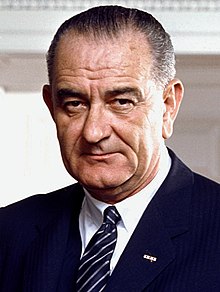
In the presidential election of 1928, anti-Catholicism in Texas and across the country swung Texas away from Democratic presidential nominee Al Smith, the first time it ever voted against a Democrat in a presidential election. However, it was not until the middle of the 20th century that the Democrats began to face a growing challenge from the Republican Party in earnest. The 1950s was a decade of factionalism and infighting for the Texas Democratic Party, mainly between liberal and conservative Democrats, and the Republicans managed to carry Texas for native Dwight D. Eisenhower in 1952 and 1956. Cohesion returned to the party in the 1960s, and the Democratic ticket carried Texas in the 1960 presidential election with prominent Texas Senator Lyndon B. Johnson running for Vice President. In 1962, John B. Connally, a moderate Democrat, was elected Governor of Texas. The next year, the assassination of President John F. Kennedy on a trip to Dallas created further impetus to bridge the gap between liberal and moderate Texas Democrats; Party unity was solidified with Johnson's ensuing Presidency and the drubbing of Barry Goldwater in the 1964 presidential election. In 1964, Johnson carried his home state with ease, but liberal forces in Texas were in decline. In the 1968 presidential election, Democrat Hubert Humphrey barely managed to win Texas.
In 1976, Jimmy Carter became the last Democratic presidential candidate to carry Texas, and the tide was clearly turning when Democrats lost the gubernatorial election of 1978. Bill Clements was the first Republican governor since Reconstruction. By the 1990s Republicans had gained a strong foothold in the state, and throughout the 21st century they have been largely victorious. Currently, both houses of the Texas Legislature feature Republican majorities.[11]
In 2018, Democratic U.S. Representative Beto O'Rourke lost his Senate bid to the incumbent Republican Ted Cruz by about 200,000 votes, a significant gain for Democrats in the state. O'Rourke's performance in the 2018 Senate race has shaken the notion of Republican dominance in Texas, with analysts predicting greater gains for the Democrats going into the 2020s.[12]
Since the passage of the Affordable Care Act, Texas Democrats have prioritized advocating Medicaid expansion in the state, a policy that would provide a federally subsidized healthcare plan to approximately one million Texans.[13][14] Another priority for Texas Democrats in the 2010s and 2020s has been increasing the minimum wage.[15][16]
Activities
[edit]The Texas Democratic Party is the primary organization responsible for increasing the representation of its ideological base in state, district, county, and city government. Its permanent staff provides training and resources for Democratic candidates within the state, particularly on grassroots organization and fundraising.[17] The Party organization monitors political discourse in the state and speaks on behalf of its members. The party employs a full-time Communications Director who is responsible for the organization's communications strategy, which includes speaking with established state and national media. Press releases regarding current issues are often released through the by permanent staff.[18] The party also maintains a website with updates and policy briefs on issues pertinent to its ideological base. Its online presence also includes Facebook, Instagram, and Twitter accounts, each of which has thousands of followers and is used to update followers on the most recent events affecting the party. The Party also oversees several e-mail and text messaging groups that send periodic updates to millions of followers.[11]
A major function of the Texas Democratic Party is to raise funds to maintain the electoral infrastructure within its organization. Funds are used to provide for a permanent staff, publish communication and election material, provide training to candidates, and to pay for legal services.
The organization hosts biennial conventions that take place at precinct, county, and state level. The purpose of the precinct convention is to choose delegates to the county convention, and the delegates who gather at the county conventions are mainly concerned with selecting delegates to the state convention. The purpose of the state convention is to appoint the state executive committee, adopt a party platform, and officially certify the party's candidates to be listed on the general election ballot. The State Democratic Executive Committee (SDEC) includes one Committeeman and one Committeewoman from each of the 31 districts, plus a chairman and a vice-chairman. The SDEC members are elected by the convention's delegates.[11] In presidential election years, the state convention also chooses delegates to go to the Democratic National Convention. Delegates also elect a state party chair. At the 2012 Texas Democratic Party Convention in Houston, delegates elected Gilberto Hinojosa as the new chair of the state party. Hinojosa is a former school board trustee, district judge, and county judge from Cameron County.[19] Hinojosa replaced retiring chair Boyd Richie, who had been chair since April 22, 2006.
The State Democratic Executive Committee adopted the 2020 Delegate Selection Plan for submission to the Rules and Bylaws Committee of the Democratic National Committee. Texas sends the second largest delegation to the Democratic National Convention. Texas’ delegation is 281 persons, 262 delegates and 19 alternates. The delegates selected are in three categories: 149 District-Level delegates selected by attendees at the state convention by senate district caucuses of the supporters of each candidate who wins delegates. A candidate must have won at least 15% of the vote in the senate district to win district delegates. While looking at the statewide votes, the Texas Democratic Party also examines how each candidate performed in each of the 31 state senate districts. The same rule applies that a candidate must have won at least 15% of the vote in the senate district to win district delegates.[20]
On December 2, 2023[21] the Texas Democratic Party was "the first among all states" to call for a ceasefire in Gaza.[22]
Current elected officials
[edit]The Texas Democratic Party holds 13 of the state's 38 U.S. House seats, 12 of the state's 31 Texas Senate seats, and 64 of the state's 150 Texas House of Representatives seats.
Members of Congress
[edit]U.S. Senate
[edit]- None
Both of Texas's U.S. Senate seats have been held by Republicans since 1993. Bob Krueger was the last Democrat to represent Texas in the U.S. Senate. Appointed in January 1993 by then Governor Ann Richards to fill the vacancy left by Lloyd Bentsen after Bentsen's appointment as the U.S. Secretary of the Treasury, Krueger lost his bid for a full term to Republican challenger Kay Bailey Hutchison. Lloyd Bentsen was the last Democrat to represent Texas for a full term in the U.S. Senate from 1983 to 1989.
U.S. House of Representatives
[edit]As of the 2022 elections, out of the 38 seats Texas is apportioned in the U.S. House of Representatives, 12 are held by Democrats:[23][24]
| District | Member | Photo |
|---|---|---|
| 7th | Lizzie Fletcher | 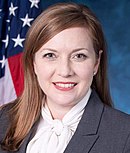 |
| 9th | Al Green | 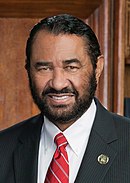 |
| 16th | Veronica Escobar | 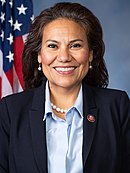 |
| 20th | Joaquin Castro | 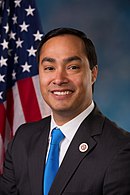 |
| 28th | Henry Cuellar | 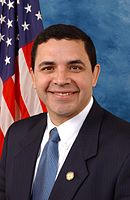 |
| 29th | Sylvia Garcia | 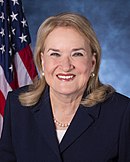 |
| 30th | Jasmine Crockett |  |
| 32nd | Colin Allred | 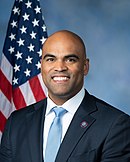 |
| 33rd | Marc Veasey | 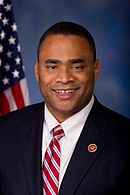 |
| 34th | Vicente Gonzalez | 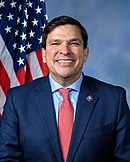 |
| 35th | Greg Casar | 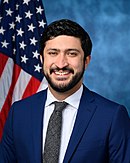 |
| 37th | Lloyd Doggett | 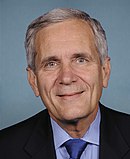 |
Statewide offices
[edit]- None
Texas has not elected any Democratic candidates to statewide office since 1994, when Bob Bullock, Dan Morales, John Sharp, and Garry Mauro were re-elected as lieutenant governor, attorney general, comptroller, and land commissioner, respectively. In 1998, Bullock and Morales both opted to retire instead of seeking third terms while Mauro and Sharp unsuccessfully ran for governor and lieutenant governor, losing to Republican challengers George W. Bush and Rick Perry.
Legislative leadership
[edit]- Senate Minority Leader: Carol Alvarado
- Speaker Pro Tempore of the House: Vacant
- House Minority Leader and Caucus Chair: Trey Martinez Fischer
Party officers
[edit]During the 2018 Texas Democratic Convention, Gilberto Hinojosa was re-elected as Chairman by an overwhelming margin. Joining Hinojosa in leadership were newly elected Vice-Chair Carla Brailey, Treasurer Mike Floyd, and Vice Chair of Finance Chris Hollins. Brailey, Floyd, and Hollins were elected by voice vote in margins similar to Hinojosa. Secretary Lee Forbes was re-elected in an uncontested race. Following the 2024 Texas elections, Party chairman Gilberto Hinojosa announced his resignation.[25]
- Chairman: Gilberto Hinojosa (Acting)
- Vice Chair: Dr. Carla Brailey
- Treasurer: Mike Floyd[26]
- Vice Chair of Finance: Chris Hollins
- Secretary: Lee Forbes
- Sergeant at Arms: Donna Beth McCormick
- Parliamentarian: Rick Cofer
- Parliamentarian: Ross Peavey
- Parliamentarian: Marty Galindo
Texas Senate
[edit]The following Democrats represent their districts in the Texas Senate:[27][28]
- Carol Alvarado, District 6
- Borris Miles, District 13
- Sarah Eckhardt, District 14
- Nathan Johnson, District 16
- Roland Gutierrez, District 19
- Juan "Chuy" Hinojosa, District 20
- Judith Zaffirini, District 21
- Royce West, District 23
- Jose Menendez, District 26
- Eddie Lucio, Jr., District 27
- José R. Rodríguez, District 29
Texas House of Representatives
[edit]The following Democrats represent their districts in the Texas House of Representatives:[29]
- Joe Deshotel, District 22
- Ron Reynolds, District 27
- Abel Herrero, District 34
- Oscar Longoria, District 35
- Sergio Muñoz (politician), District 36
- Alex Dominguez, District 37
- Eddie Lucio III, District 38
- Armando Martinez, District 39
- Terry Canales, District 40
- Robert Guerra, District 41
- Richard Raymond, District 42
- Erin Zwiener, District 45
- Sheryl Cole, District 46
- Vikki Goodwin, District 47
- Donna Howard, District 48
- Gina Hinojosa, District 49
- Celia Israel, District 50
- Eddie Rodriguez, District 51
- James Talarico, District 52
- Michelle Beckley, District 65
- Mihaela Plesa , District 70
- Poncho Nevárez, District 74
- Mary Gonzalez, District 75
- Cesar Blanco, District 76
- Lina ortega, District 77
- Joe Moody, District 78
- Tracy King, District 80
- Ramon Romero Jr., District 90
- Nicole Collier, District 95
- Eric Johnson, District 100
- Chris Turner (politician), District 101
- Ana-Maria Ramos, District 102
- Rafael Anchia, District 103
- Jessica Gonzalez, District 104
- Terry Meza, District 105
- Victoria Neave, District 107
- Carl Sherman, District 109
- Toni Rose, District 110
- Yvonne Davis, District 111
- Rhetta Bowers, District 113
- John Turner, District 114
- Julie Johnson, District 115
- Trey Martinez Fischer, District 116
- Philip Cortez, District 117
- Leo Pacheco, District 118
- Roland Gutierrez, District 119
- Barbara Gervin-Hawkins, District 120
- Diego Bernal, District 123
- Ina Minjarez, District 124
- Alma Allen, District 131
- Ann Johnson, District 134
- Jon E. Rosenthal, District 135
- John Bucy III, District 136
- Gene Wu, District 137
- Jarvis Johnson, District 139
- Armando Walle, District 140
- Senfronia Thompson, District 141
- Harold Dutton Jr., District 142
- Ana Hernandez, District 143
- Mary Ann Perez, District 144
- Shawn Thierry, District 146
- Garnet F. Coleman, District 147
- Jessica Farrar, District 148
- Hubert Vo, District 149
State Board of Education
[edit]The following members of the State Board of Education are Democrats; they help oversee the Texas Education Agency:[30]
- Georgina Perez, District 1
- Ruben Cortez Jr., District 2
- Marisa Perez, District 3
- Lawrence A. Allen, Jr., District 4
- Rebecca Bell-Metereau, District 5
- Aicha Davis, District 13
Mayors
[edit]- Houston: John Whitmire (1)
- Austin: Kirk Watson (4)
- El Paso: Oscar Leeser (6)
References
[edit]- ^ "Texas Democratic Party Chair Gilberto Hinojosa Announces Resignation". 8 November 2024.
- ^ "Contact". Texas Democratic Party. 2012. Retrieved 2012-06-04.
- ^ "Who Were the Southern Democrats?". National Review. 2014-09-17. Retrieved 2023-04-20.
- ^ Staff (2020-11-13). "Not Always a Red State: A History of Texas' Political Transformation". Reform Austin. Retrieved 2023-04-20.
- ^ Maxwell, Angie (2020-03-02). "What Makes Southern Democrats Unique". FiveThirtyEight. Retrieved 2023-04-20.
- ^ "Our Platform". Texas Democratic Party. Retrieved 2023-04-20.
- ^ "Texas Governor Midterm Election 2022: Live Results and Updates". www.nbcnews.com. Retrieved 2023-04-20.
- ^ Herrera, Jack (2021-09-13). "Why Democrats Are Losing Texas Latinos". Texas Monthly. Retrieved 2023-04-20.
- ^ "Texas State Historical Association". Retrieved 19 August 2012.
- ^ "Scalawag#cite ref-1." Republican Politics and Reconstruction
- ^ a b c Young, Nancy Beck. "Democratic Party". Texas State Historical Association. Retrieved 2012-06-10.
- ^ "Article from the Washington Post". The Washington Post. 2018-11-07. Retrieved 2018-11-09.
- ^ Engel, John (October 2020). "Eyeing a majority in the Texas House, Democrats prioritize Medicaid expansion". KXAN. Retrieved 26 January 2021.
- ^ Ramirez, Fernando (8 October 2020). "Texas House Democrats reveal healthcare plan for 2021". The Texas Signal. Retrieved 26 January 2021.
- ^ Waller, Allyson (20 December 2018). "As most states raise their minimum wages, Texas refuses to budge". The Texas Tribune. Retrieved 26 January 2021.
- ^ DeGrave, Sam (13 January 2017). "Texas Democrats Push For At Least $10.10 Minimum Wage". Texas Observer. Retrieved 26 January 2021.
- ^ [1] Texas State Historical Association: Texas Democratic Handbook. Retrieved December 5, 2011
- ^ "TDP Staff | Texas Democratic Party". Archived from the original on 2012-09-14. Retrieved 2011-12-10. Texas Democratic Party Official Website: Media Staff. Retrieved December 5, 2011
- ^ Ramsay, Ross; Aguilar, Julián (2012-06-09). "Texas Democrats Elect Their First Hispanic Chairman". Retrieved August 19, 2012.
- ^ https://act.txdemocrats.org/page/-/Rules%20of%20the%20Texas%20Democratic%20Party%20June%2C%202018%20%281%29.pdf [dead link]
- ^ "Texas State Democratic Executive Committee Unanimously Passes Israeli-Palestinian Resolution, Calls for a Humanitarian Ceasefire and Release of Hostages". Texas Democratic Party. Retrieved 2024-04-23.
- ^ Bova, Gus (2024-01-24). "Will Texas Cities Stay Silent on Gaza?". The Texas Observer. Retrieved 2024-04-23.
- ^ "Texas Election Results 2022: Live Map | Midterm Races by County & District". www.politico.com. Retrieved 2022-12-12.
- ^ "United States House of Representatives elections in Texas, 2022". Ballotpedia. Retrieved 2022-12-12.
- ^ Scherer, Jasper (8 November 2024). "Texas Democratic Party chair resigns after election blowout".
- ^ Wallace, Jeremy (2018-06-23). "Pearland 19-year-old Mike Floyd becomes part of Texas Democrats leadership team". Houston Chronicle. Retrieved 2019-01-19.
- ^ Elected Officials Texas Tribune. Retrieved June 16, 2015
- ^ "The Texas State Senate – Members of the Texas Senate". www.senate.texas.gov. Retrieved 2021-02-09.
- ^ [2] TexasDemocrats.Org Retrieved June 25, 2019
- ^ "SBOE Members". Texas Education Agency. Retrieved 2021-02-19.
External links
[edit]the Texas Democratic Party were elected at the 2018 State Convention in Fort Worth, Texas and will serve

